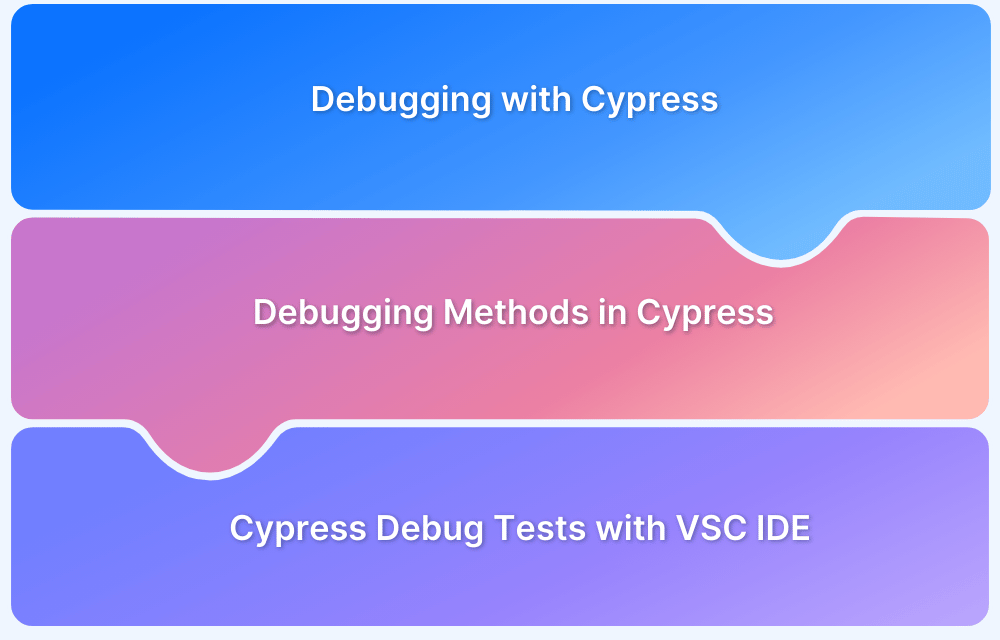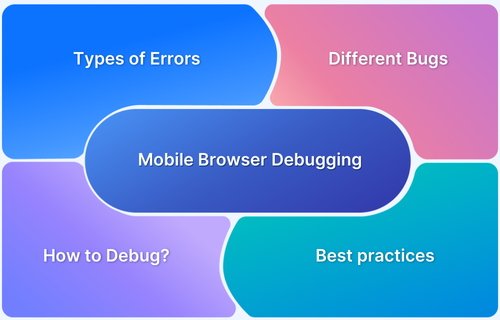Difference between Testing and Debugging
By Ansa Anthony, Community Contributor - December 5, 2024
Testing and debugging are distinct but interconnected processes in software development. While testing focuses on prevention, debugging concerns problem-solving, and resolution
A quick overview of the critical difference between Testing and Debugging:
- Testing is conducted to verify a software system’s functionality, performance, and reliability to identify defects or errors.
- Debugging is investigating and resolving those defects, aiming to eliminate issues and ensure smooth operation.
This article will cover the basics, their importance, stages, and detailed differences between testing and debugging.
Importance of Testing and Debugging
Testing and debugging in a unified princess are of utmost importance within any SDLC model or phase for several key reasons:
- Ensuring Software Quality: These processes ensure the software behaves as intended and delivers the expected outcomes.
- Reducing Software Defects: By conducting thorough testing, developers can identify and eliminate defects, bugs, and errors in the software.
- Improving User Experience (UX): Through testing and debugging, usability issues, interface glitches, and performance bottlenecks can be detected and resolved.
- Enhancing Productivity & Efficiency: By addressing issues early in the software development process, developers can prevent potential disruptions and save time that would otherwise be spent on reworking or fixing bugs later.
- Saving Time & Costs: Detecting and resolving defects during the testing and debugging stages is more cost-effective and time-efficient than addressing them after deploying the software.
What is Testing?
Software Testing is a systematic and controlled process of evaluating a software system or application to determine its behavior, functionality, and performance. A team can undertake different types of testing depending on their project requirements.
- It involves designing and executing various test cases to validate whether the software meets the specified requirements and works as intended.
- Testing identifies defects, bugs, and inconsistencies early in the development cycle, ensuring the delivery of a high-quality software product.
- Ensuring software quality, enhancing user satisfaction, and reducing risks associated with software failures is crucial.
What are the stages of Testing?
The stages of testing can vary depending on the software development lifecycle or methodology being followed. However, a general framework of testing stages typically includes the following:
- Test Planning: This stage involves creating a comprehensive test plan that outlines the testing approach, objectives, scope, resources, and timelines. It also includes identifying test requirements, test cases, and test data.
- Test Design: Test cases are designed based on this stage’s defined requirements and specifications. Test scenarios, scripts, and data are prepared to ensure adequate software functionality coverage.
- Test Execution: Test execution involves running the designed test cases, executing test scripts, and observing the actual outcomes of the software. Testers compare the actual and expected results and report any deviations or defects.
- Test Reporting: Test reporting involves documenting the test results, including any defects or issues discovered during testing. It includes detailed reports on test coverage, execution status, and defect metrics.
- Test Closure: The test closure stage involves evaluating the overall testing process and determining whether the exit criteria have been met. It includes reviewing the test artifacts, identifying lessons learned, and preparing a final test report.
Additionally, it is worth noting that these stages can be iterative, overlapping, or adapted based on the project’s specific needs. Different test methodologies, such as Agile or DevOps, may have their unique variations or additional stages within the testing process.
Types of Testing
Testing ensures that software works as expected and meets user requirements. It comes in various forms, each with a specific goal:
- Functional Testing: Verifies if the software performs its intended functions.
- Unit Testing: Tests individual components or modules in isolation.
- Integration Testing: Checks how different modules work together.
- System Testing: Validates the entire application as a whole.
- Regression Testing: Ensures new changes don’t break existing features.
- Performance Testing: Measures how the software performs under load or stress.
- Security Testing: Identifies vulnerabilities and ensures data protection.
- User Acceptance Testing (UAT): Confirms the software meets user needs before release.
What is Debugging?
Debugging is identifying, analyzing, and resolving defects or issues in software or computer systems. It is critical in ensuring software applications’ reliability, stability, and quality.
- It involves investigating and troubleshooting problems to determine the cause of unexpected behavior or errors.
- Debugging aims to rectify the identified issues, allowing the software to function correctly and as intended.
- Debugging often involves techniques such as analyzing log files, using debugging tools, inspecting code, and conducting step-by-step execution to pinpoint and fix the problem areas.
What are the stages of Debugging?
The stages of debugging typically involve the following steps:
- Observation: The initial debugging stage involves observing the software’s behavior and symptoms to identify any issues or unexpected behavior. This may include error messages, crashes, incorrect outputs, or abnormal behavior.
- Reproducing the Issue: The first step is consistently reproducing the problem. This may involve gathering information about the specific scenario, inputs, and conditions that trigger the issue.
- Identifying the Root Cause: Developers analyze the code, examine error messages, and debug the software to understand the underlying cause.
- Isolating the Problem: This helps narrow the focus and avoid making unnecessary changes to unrelated parts of the software.
- Fixing the Issue: This may involve modifying the code, adjusting configurations, or improving error handling to rectify the identified problem.
- Testing and Validation: Once the fixes are implemented, thorough testing and validation are performed to ensure the issue has been resolved successfully. This includes retesting the problem scenario, running regression tests, and conducting additional tests to verify the effectiveness of the corrections.
- Documentation: It is crucial to document the debugging process, including the observed symptoms, root cause, applied fixes, and testing outcomes. Documentation is a reference for future debugging efforts, aids knowledge sharing, and helps maintain a record of resolved issues.
Read More: Best Practices for Debugging Website Issues
Testing vs Debugging: Comparison
Here is a detailed list of differences between testing and debugging:
| Aspect | Testing | Debugging |
|---|---|---|
| Purpose and Objectives | Identifies defects and ensures software meets requirements. | Analyzes and fixes defects found during testing or production. |
| Timing and Scope | Occurs throughout the SDLC, especially during testing phases. | This takes place after defects are identified, typically post-testing. |
| Roles and Responsibilities | Primarily handled by testers or QA teams. | Carried out by developers or engineers familiar with the codebase. |
| Types of Issues Addressed | Focuses on detecting bugs, performance issues, and requirement mismatches. | Focuses on fixing code-level bugs and logical errors. |
| Tools and Techniques Used | Uses test management tools (e.g., Selenium, JUnit, TestRail) and techniques like black-box or white-box testing. | Relies on debugging tools (e.g., GDB, Chrome DevTools) and techniques like code tracing and logging. |
| Importance/Priority | Critical for identifying whether the software is ready for release. | Essential for ensuring that identified issues are resolved effectively. |
| Outcome | Produces a report of issues found, indicating areas requiring fixes. | Results in a corrected, working version of the software. |
| Focus | Validation of functionality, usability, and performance. | Root cause analysis and code correction. |
How to Test & Debug with BrowserStack?
To test on the BrowserStack Real Device Cloud, simply sign in and choose your test environment and configurations depending on manual or automated testing.
1. Live: Perform cross-browser testing on real Android and iOS devices on the cloud. Tests new and old versions of Edge, Safari, Chrome, IE, and Firefox on Windows and macOS.
2. App Live: Test apps on the latest and legacy flagship devices, including iPhone, Samsung Galaxy, Pixel, Nexus, and more, on multiple Android and iOS versions. Leverage 15+ native device features like GPS, network simulation, and localization.
3. Automate: Harness the Cloud Selenium grid to start testing instantly on 3000+ real mobile devices and desktop browsers. Integrate in minutes using popular languages and frameworks.
4. App Automate: Automated mobile app testing is easier by integrating with BrowserStack using Appium, Espresso, XCUITest, Flutter, and Detox. Simply install the SDK, set up a YAML file, and trigger your tests as usual.
5. Percy: Automate your visual testing by capturing screenshots, comparing them against the baseline, and highlighting visual changes. With increased visual coverage, teams can confidently deploy code changes with every commit.
6. App Percy: Automate your visual testing for mobile apps with AI-based workflows on the largest real device cloud.
7. Accessibility Testing: Test for accessibility issues at speed and experience hassle-free reporting using the central reporting hub,
You can remotely debug and inspect code, reproduce issues, and capture screenshots or videos for troubleshooting. Once the bug is captured, it is easier to share it with your team remotely with integrations like Slack, Jira, Azure DevOps, GitHub, and Trello.
With the latest BrowserStack Test Observability, debugging and insight gathering is faster.
- Instantly pinpoint failure reasons with ML-based categorizations like product, automation, or environment issues.
- Access every log – framework, video, screenshot, terminal, network & even application logs – chronologically sorted in a single pane.
- Troubleshoot test suite health with built-in dashboards for metrics like stability and flakiness.
- Supports popular frameworks like Java TestNG, WebdriverIO, Cypress, Playwright, Nightwatch, MochaJS, JUnit Reports.




